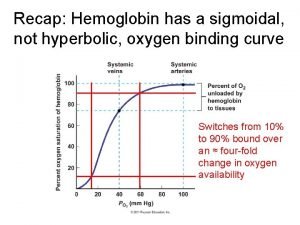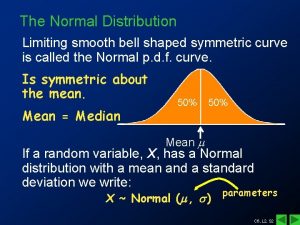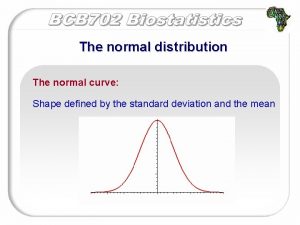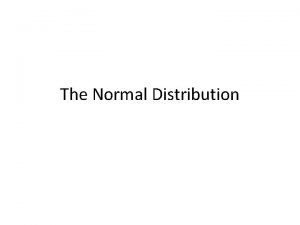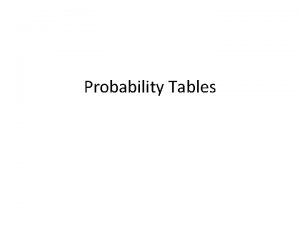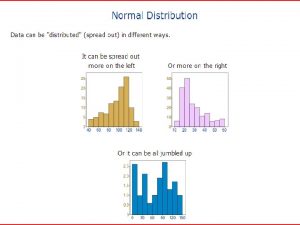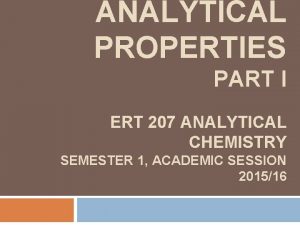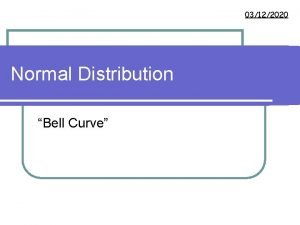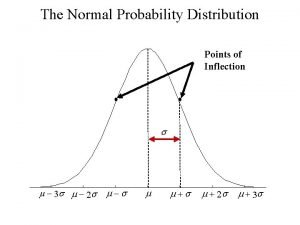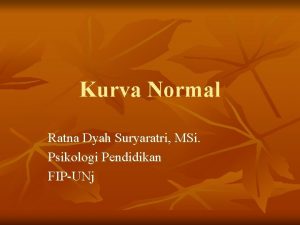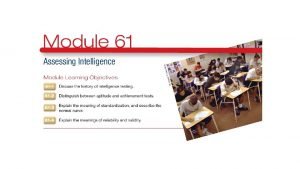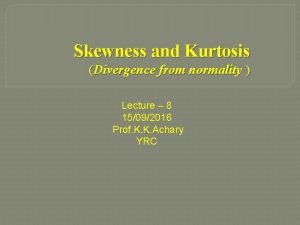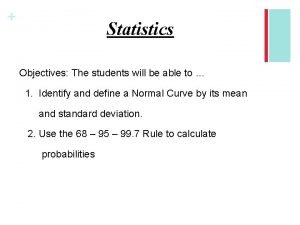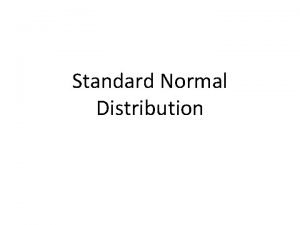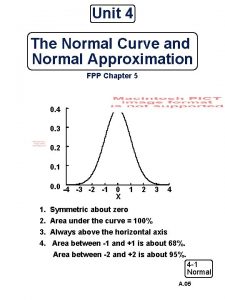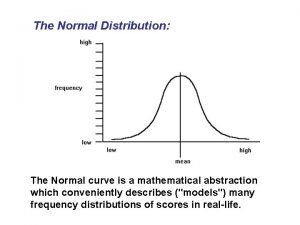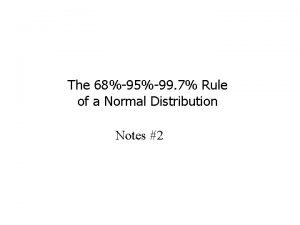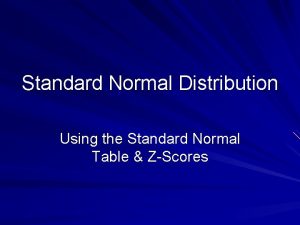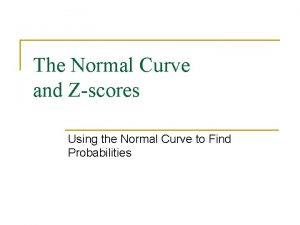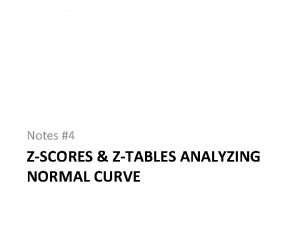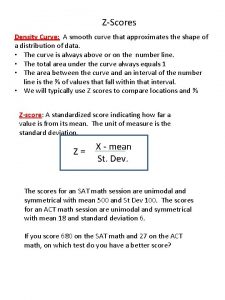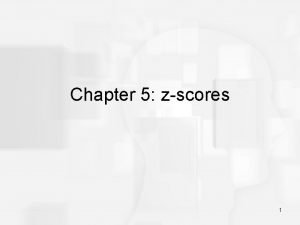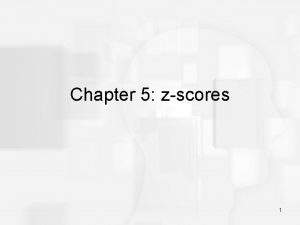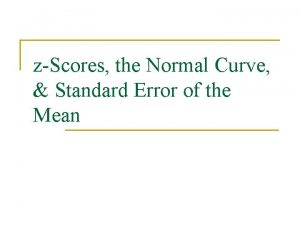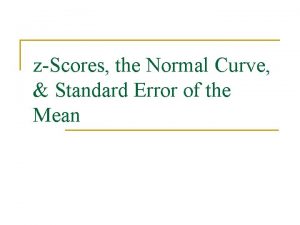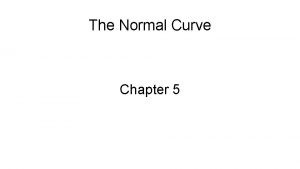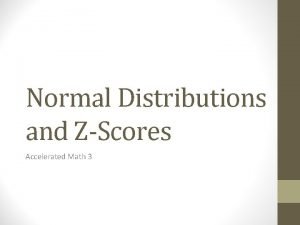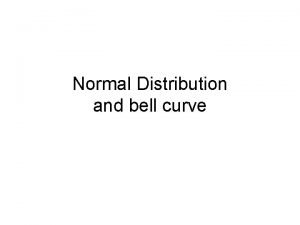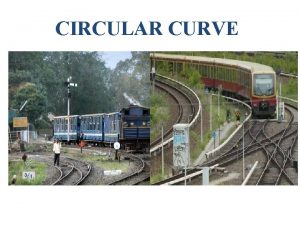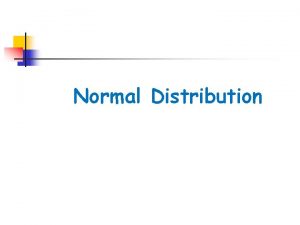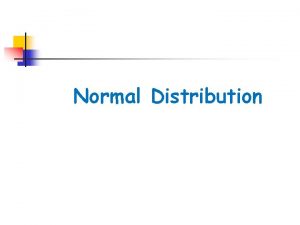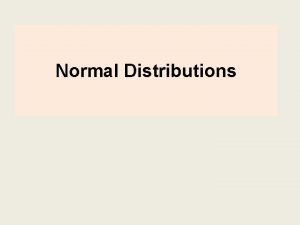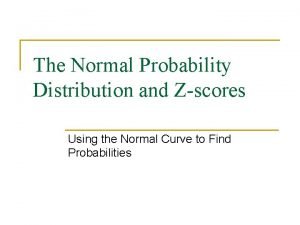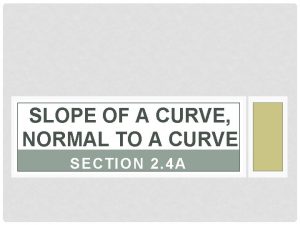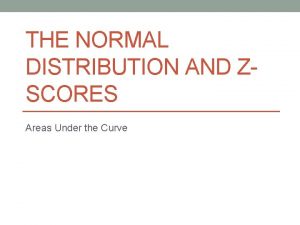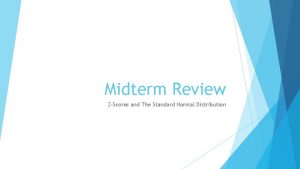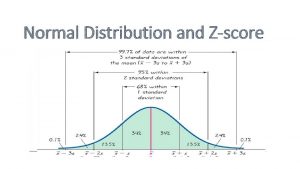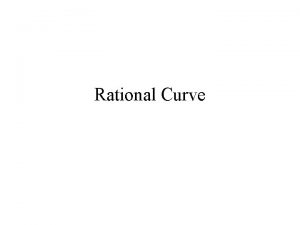The Normal Curve and Zscores Using the Normal

































- Slides: 33

The Normal Curve and Z-scores Using the Normal Curve to Find Probabilities

Outline n n n 1. Properties of the normal curve. 2. Mean and standard deviation of the normal curve. 3. Area under the curve. 4. Calculating z-scores. 5. Probability.

Carl Gauss n n The normal curve is often called the Gaussian distribution, after Carl Friedrich Gauss, who discovered many of its properties. Gauss, commonly viewed as one of the greatest mathematicians of all time (if not the greatest), is honoured by Germany on their 10 Deutschmark bill. From http: //www. willamette. edu/~mjaneba/help/normalcurve. html

The Histogram and the Normal Curve

The Theoretical Normal Curve (from http: //www. music. miami. edu/research/statistics/normalcurve/images/normal. Curve 1. gif

Properties of the Normal Curve: n n n n Theoretical construction Also called Bell Curve or Gaussian Curve Perfectly symmetrical normal distribution The mean of a distribution is the midpoint of the curve The tails of the curve are infinite Mean of the curve = median = mode The “area under the curve” is measured in standard deviations from the mean

Properties (cont. ) n n Has a mean = 0 and standard deviation = 1. General relationships: ± 1 s = about 68. 26% ± 2 s = about 95. 44% ± 3 s = about 99. 72%

Z-Scores n n Are a way of determining the position of a single score under the normal curve. Measured in standard deviations relative to the mean of the curve. The Z-score can be used to determine an area under the curve known as a probability. Formula: Z = (Xi – ) / S

Using the Normal Curve: Z Scores n Procedure: n To find areas, first compute Z scores. Substitute score of interest for Xi Use sample mean for and sample standard deviation for S. The formula changes a “raw” score (Xi) to a standardized score (Z). n n n

Using Appendix A to Find Areas Below a Score n n n Appendix A can be used to find the areas above and below a score. First compute the Z score, taking careful note of the sign of the score. Make a rough sketch of the normal curve and shade in the area in which you are interested.

Using Appendix A (cont. ) n Appendix A has three columns (a), (b), and (c) q q (a) = Z scores. (b) = areas between the score and the mean

Using Appendix A (cont. ) q ( c) = areas beyond the Z score

Using Appendix A n n n Suppose you calculate a Z-score = +1. 67 Find the Z-score in Column A. To find area below a positive score: q n Add column b area to. 50. To find area above a positive score q Look in column c. (a) (b) (c) . . . 1. 66 0. 4515 0. 0485 1. 67 0. 4525 0. 0475 1. 68 0. 4535 0. 0465 . . .

The area below Z = 1. 67 is Using Appendix A (cont. ) 0. 4525 + 0. 5000 = 0. 9525. n n Areas can be expressed as percentages: q 0. 9525 = 95. 25%

Normal curve with z=1. 67

Using Appendix A n n What if the Z score is negative (– 1. 67)? To find area below a negative score: q n Look in column c. To find area above a negative score q Add column b. 50 (a) (b) (c) . . . 1. 66 0. 4515 0. 0485 1. 67 0. 4525 0. 0475 1. 68 0. 4535 0. 0465 . . .

Using Appendix A (cont. ) n n The area below Z = - 1. 67 is. 0475. Areas can be expressed as %: 4. 75%. Area =. 0475 z= -1. 67

Finding Probabilities n Areas under the curve can also be expressed as probabilities. n Probabilities are proportions and range from 0. 00 to 1. 00. n The higher the value, the greater the probability (the more likely the event). For instance, a. 95 probability of rain is higher than a. 05 probability that it will rain!

Finding Probabilities n If a distribution has: q q n = 13 s = 4 What is the probability of randomly selecting a score of 19 or more?

Finding Probabilities (a) (b) (c) . . . 1. 49 0. 4319 0. 0681 1. 50 0. 4332 0. 0668 1. 51 0. 4345 0. 0655 . . . 1. 2. 3. 4. Find the Z score. For Xi = 19, Z = 1. 50. Find area above in column c. Probability is 0. 0668 or 0. 07.

In Class Example n n n After an exam, you learn that the mean for the class is 60, with a standard deviation of 10. Suppose your exam score is 70. What is your Z-score? Where, relative to the mean, does your score lie? What is the probability associated with your score (use Z table Appendix A)?

To solve: n Available information: Xi = 70 = 60 S = 10 n Formula: Z = (Xi – ) / S = (70 – 60) /10 = +1. 0

Your Z-score of +1. 0 is exactly 1 s. d. above the mean (an area of 34. 13% + 50% percentile. ) You are at the 84. 13

What if your score is 72? n Calculate your Z-score. n What percentage of students have a score below your score? Above? n What percentile are you at?

Answer: n Z = 1. 2 n The area beyond Z =. 1151 (11. 51% of marks are above yours) Area between mean and Z =. 3849 +. 50 =. 8849 (% of marks below = 88. 49%) n n Your mark is at the 88 th percentile!

What if your mark is 55%? n Calculate your Z-score. n What percentage of students have a score below your score? Above? n What percentile are you at?

Answer: n Z = -. 5 Area between the mean and Z =. 1915 +. 50 =. 6915 (% of marks above = 69. 15%) n n The area beyond Z =. 3085 (30. 85% of the marks are below yours) n Your mark is only at the 31 st percentile!

Another Question… n What if you want to know how much better or worse you did than someone else? Suppose you have 72% and your classmate has 55%? n How much better is your score?

Answer: n Z for 72% = 1. 2 or. 3849 of area above mean n Z for 55% = -. 5 or. 1915 of area below mean n Area between Z = 1. 2 and Z = -. 5 would be. 3849 + . 1915 =. 5764 n Your mark is 57. 64% better than your classmate’s mark with respect to the rest of the class.

Probability: n Let’s say your classmate won’t show you the mark…. n How can you make an informed guess about what your neighbour’s mark might be? n What is the probability that your classmate has a mark between 60% (the mean) and 70% (1 s. d. above the mean)?

Answer: n Calculate Z for 70%. . . Z = 1. 0 n In looking at Appendix A, you see that the area between the mean and Z is. 3413 n There is a. 34 probability (or 34% chance) that your classmate has a mark between 60% and 70%.

The probability of your classmate having a mark between 60 and 70% is. 34 :

Homework Questions: n Healey 1 st Cdn: #5. 1, 5. 3, 5. 5* Healey 2/3 Cdn: #4. 1, 4. 3, 4. 5* *Answers can be found at back of text n Read SPSS section at end of chapter n n
 Zscorelive
Zscorelive S curve and j curve
S curve and j curve S curve and j curve
S curve and j curve Sigmoidal and hyperbolic curve
Sigmoidal and hyperbolic curve Bilateral balanced occlusion
Bilateral balanced occlusion The normal curve is smooth and symmetric.
The normal curve is smooth and symmetric. How to find mean on desmos
How to find mean on desmos Shape normal
Shape normal How does changing the mean affect a normal curve
How does changing the mean affect a normal curve Norm dist table
Norm dist table Phi function table
Phi function table Normal error curve in analytical chemistry
Normal error curve in analytical chemistry Bell curve characteristics
Bell curve characteristics Normal curve inflection points
Normal curve inflection points Dari 100 responden didapat harga rata rata untuk angket
Dari 100 responden didapat harga rata rata untuk angket Wechsler normal curve
Wechsler normal curve Wechsler normal curve
Wechsler normal curve Two examples of divergence from normality
Two examples of divergence from normality Tiger woods
Tiger woods The area under a standard normal curve is?
The area under a standard normal curve is? Normal curve approximation
Normal curve approximation How to find the area under normal curve
How to find the area under normal curve Normal curve 68-95-99
Normal curve 68-95-99 Using system.collections
Using system.collections Dtfd switch
Dtfd switch Using standard normal table
Using standard normal table Hình ảnh bộ gõ cơ thể búng tay
Hình ảnh bộ gõ cơ thể búng tay Slidetodoc
Slidetodoc Bổ thể
Bổ thể Tỉ lệ cơ thể trẻ em
Tỉ lệ cơ thể trẻ em Chó sói
Chó sói Chụp tư thế worms-breton
Chụp tư thế worms-breton Hát lên người ơi alleluia
Hát lên người ơi alleluia Môn thể thao bắt đầu bằng từ chạy
Môn thể thao bắt đầu bằng từ chạy



